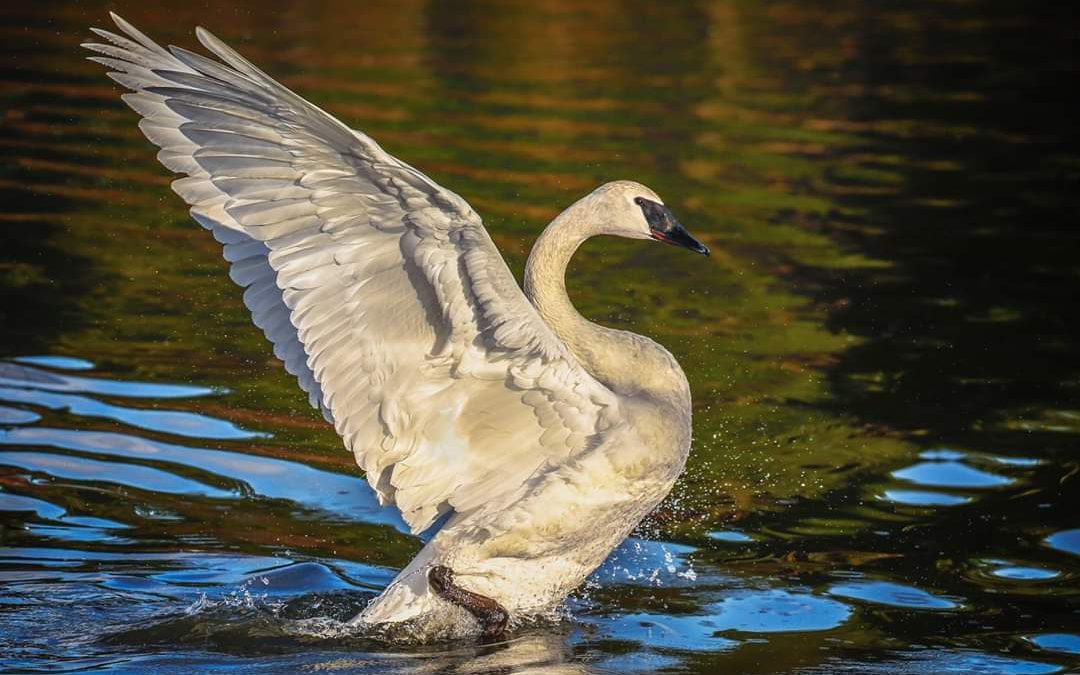-Karen Weintraub | Independent Uk
The trumpeter swan was on the brink of extinction 50 years ago. But restoration efforts in Ontario have helped the species make a comeback throughout Canada and the United States, writes Karen Weintraub
Bev Kingdon rattles off the names of trumpeter swans and their personalities as if describing her children. Pig Pen was named for her eating habits; 672 cleverly avoided tagging; 206 nearly died of lead poisoning but nursed himself back to health and then fought off his wife’s new mate to reclaim their relationship.
In the past 30 years, Kingdon has been part of a small coterie of volunteers who have helped restore trumpeter swans to Ontario, Canada. North America’s largest waterfowl, the trumpeter was nearly extinct in Canada and the lower 48 states for the better part of a century – brought down by the shotguns of Europeans.
Now, these majestic birds are a success story.
There are more than 1,000 trumpeters in Ontario that headed north last month, many to raise their next brood. Restoration projects have also been successful in the United States, in the upper Midwest states of Minnesota, Wisconsin, Iowa, Ohio and Michigan, returning swans to at least some of the areas they inhabited before Europeans arrived in North America.
The natural population in Alaska, which became a key source for the restoration efforts, also remains strong, with more than 22,000 adults counted in the last aerial survey conducted in 2015.
For reasons that are not entirely clear, similar restoration efforts in Western states have struggled.
“It’s been a labour of love for a lot of people all across North America to help bring back the trumpeter swans,” says Margaret Smith, executive director of the Trumpeter Swan Society, which has supported restoration efforts for 50 years.
Now that conservation agencies’ efforts have led to a critical mass of animals in a number of states, the swans are spreading naturally. North Dakota, Indiana and New York, which don’t have restoration projects, have all reported nesting pairs. Trumpeter swans have also been sighted in Pennsylvania, Virginia, Maryland, North Carolina, Oklahoma and Texas.
“Folks get really excited about it,” Smith says. One swan got blown to Arkansas in a snowstorm in the early 1990s, and wintered in Heber Springs, north of Little Rock, she says. It returned the next year, and now Heber Springs promotes its winter swan population as a tourist attraction.
The birds have a wingspan that can reach 8ft across (iStock)
“These are all pioneering birds,” Smith says. “For us, it’s like watching history as it’s happening.”
The birds, whose wingspans can reach 8ft across, need open, fresh water that is not too deep, so they can feed off the bottom. They usually migrate south in winter to find lakes that are not frozen over. Mating for life, they often nest in the same area where the female, known as a pen, was born.
Coming in for a landing in winter, the birds sound like a group of enthusiastic four-year-olds with party horns. But once situated, they rarely make much noise, Smith says.
Trumpeter swans had been so plentiful in Ontario in the early 1700s that Antoine de la Mothe Cadillac, who commanded the French settlement that became Detroit, said they “might be taken for lilies.” But settlers and trappers wiped them out.
European settlers in North America killed the swans for food, and turned their down-covered skin into powder puffs for cosmetics and their feathers into quill pens, says Gary Ivey, a past president of the Trumpeter Swan Society. John James Audubon, the famous naturalist, preferred trumpeter swan feather quills to any others, he says.
The last wild trumpeter swan in Ontario was recorded shot in 1886.
“Our heritage was missing from Ontario altogether,” says Harry Lumsden, who retired from the Ontario Ministry of Natural Resources, in 1988, six years after starting the restoration effort there. At age 95, Lumsden continues to work for trumpeter swans nearly every day. “I’ll do anything for swans”, he says over the phone.
The Ontario reintroduction effort started with wild collected eggs from Alberta, which were placed under mute swans, a related species, to hatch. Lumsden found “cooperators” – like Kingdon and her parents – who had suitable properties and were willing to host pairs of breeding swans. In the fall, the fledglings would be relocated for the winter and then released in suitable places in the spring. In 1993, swans hatched in the wild in Ontario for the first time in more than a century.
There were so few birds that they were quite inbred, and many of their eggs did not hatch, Lumsden says. But when Michigan cut the budget for swan reintroduction in 1992, it gave Ontario the 50 Alaskan eggs from the state’s program. Three-quarters of the eggs began hatching, instead of only half.
By 2002, Ontario’s population was self-sustaining and has grown every year since. (Inspired by the swans, Meera Sulaiman, a local photographer, has an exhibit set for June in Mississauga, Ontario.)
Trumpeter swans are protected under the Migratory Bird Treaty Act, but birds are still occasionally killed by accident or on purpose. Power line strikes and illegal shootings commonly cause premature death.
In Montana, Wyoming, Nevada, Oregon and Washington state, those problems and a few others have stymied efforts to create a self-sustaining population. “We’re really struggling here in the western states,” Ivey says.
The population at Red Rock Lakes near Yellowstone is half what it once was, he says. Yellowstone’s 30 pairs have shrunk to only a few. Human activity drives the shy birds away, he says, and contributes to a loss of habitat. “It’s tough for these swans to live with people,” he says.
The few western flocks are isolated and have lost historic “flock knowledge” of the landscape, so they don’t explore enough to find others, he says. “They’re not connected. That’s the problem. They don’t know where the other birds are.”
Dr Ivey is now planning to start a population in eastern Oregon, hoping it will support the western trumpeter swans. “It’s part of their historic range and western heritage, and I think we should try to restore them best as we can,” he says.
And even the successful reintroduction projects still face challenges. “There’s hardly a square inch of habitat around the Great Lakes that hasn’t been altered by humans,” says Liz Benneian, a longtime volunteer with the Trumpeter Swan Coalition in Ontario. “We absolutely must maintain habitat if we want to protect species.”
In Lake Ontario’s LaSalle Park, where the largest number of the province’s swans spend the winter and are just now leaving for parts north, marina owners are planning a development that could limit the swans’ food supply. Swan volunteers have fought the construction project, and managed to win concessions from the developer – for now.
“They’re still a fragile species,” Benneian says. “A thousand birds isn’t a lot.”
Related posts
Global | Didi Angaye Earns A Distinction Award, Another Feather To The Cap
On a bright sunny day, in the month of July, 2024, the prestigious Staffordshire University located in the West Midlands of England organised its Award giving and Graduation ceremony to honour graduates of various educational programmes and courses which it offers. Didi Timipah Angaye,…
Olu Of Warri Bags Award In UK, Wife Advocates Return To Cultural Values
The Olu of Warri, Ogiame Atuwatse III, has received the Leadership and Community Development award at the 14th African Achievers Awards (AAA), which took place at the Parliament House, United Kingdom. The award was presented by a member of the House of Lords, London, Rt…
Brit Awards | Asake, Burna Boy And Other ‘New Cats’ Get Nominations
Nigerian singers Burna Boy, Asake, and Rema have been nominated for the 2024 Brit Awards. The nomination list for the annual music awards show was released on Wednesday 25, January 2024. Burna Boy and Asake made the ‘Best International Artiste’ category, while ‘Calm…
Brit Awards 2024 | The Full List Of Artist(e)s
This year’s Brits nominees have been revealed ahead of the ceremony in London in March. Dua Lipa is the first star confirmed to perform at the event – but how many awards is she up for? Musicians including Raye, Central Cee, J Hus and Blur are also…
Despite Increased Transfer Volume And Institutional Adoption, Bitcoin Stays Below $60K
Bitcoin’s price hovers around $59K as increased transfer volume indicates a stable demand among investors. CryptoQuant data indicates buyers are absorbing the panic selling pressure around the $57K price level. Bitwise’s latest report suggests that institutional investors are still buying Bitcoin despite the recent price…
Traders Focus On Meme Coins As Bitcoin, Ethereum And XRP Erase Recent Gains
Bitcoin, Ethereum and XRP dip under key support levels at $60,000, $2,600 and $0.60 respectively. Tron ecosystem’s meme launchpad SunPump generates over $1.1 million in revenue within twelve days of its launch. Tron network daily revenue reached a record high of $26.83 million on Tuesday,…
Top 10 Cryptocurrencies To Invest in January 2024
-Michael Adams From Bitcoin and Ethereum to Dogecoin and Tether, there are thousands of different cryptocurrencies, making it overwhelming when you’re first getting started in the world of crypto. To help you get your bearings, these are the top 10 cryptocurrencies based on their market…
The Risk And Reward Of ChatGPT In Cybersecurity
Juan is an experienced CTO with a demonstrated history of working in the computer and network security industry. He is an information technology professional skilled in SAP and Oracle applications, computer forensics, vulnerabilities research, IPS/IDS and information security. Unless you’ve been on a retreat in…











